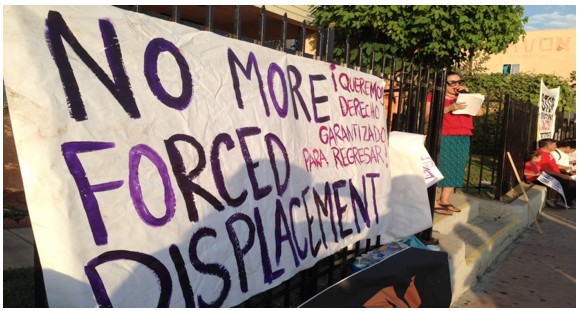CommentsKPCC SHORT LIST-Boyle Heights artist Lilia Ramirez is looking for a new place to live. The house she's rented for the past 8 years has been sold. It will soon be demolished to make way for a brand new housing complex. The search for a new apartment has been tough. If Ramirez wants to stay in Boyle Heights, it's going to cost her.
“Even here, the prices are being hiked up,” Ramirez said. “It’s been difficult, and we haven’t found anything that we really could realistically afford.”
Ramirez is one of many in Boyle Heights who is getting priced out of the neighborhood. Investors are scooping up property. New is replacing old. And typically, when a property changes hands, renters are on the losing side, given the bad news that they must move out.
KPCC wants to document displacement and track how Boyle Heights residents are resisting it. We invite our audience to tell us where they see rising rents, "going out of business" signs, and rallies to keep a beloved building.
The local Mexican restaurant Carnitas Michoacan is preparing to close its doors after 33 years. A shiny new Panda Express will be moving in. Not far from there, activists are trying to save a beloved community garden. Its 15-year lease with White Memorial Hospital ended in January.
"Sometimes you can't really stop it," Ramirez said. "We could protest. We could speak our mind. We could write about it, get some press on it, but ultimately at the end of the day, if you have the money ... it's profit before people, unfortunately."
There is little data available to pinpoint just how high rents are climbing in this pocket of Los Angeles, long known for being one of the more affordable areas. Crystal Chen, who tracks LA rents for the website Zumper told KPCC that the median price of a two-bedroom apartment in Boyle Heights is now $1450 a month, a 12 percent increase over the prior year.
Much of the city is experiencing rising rents. But residents in Boyle Heights have long had an expectation of affordability. Many of the homes are protected by LA's rent control ordinance, which prevents landlords from raising the rent more than three percent each year. Because of rent control, Boyle Heights residents tend to stay put. If they decide to move, the landlord can hike the price up to the going market rate. Neighbors have been shocked by those prices.
For example, resident Elvira Barrales told KPCC she pays a little less than $600 a month for her studio apartment, where she’s lived for the past 16 years. When a similar unit opened up in her building, it was advertised online for $1,100.
Property in this historically working-class immigrant community has become more desirable for a number of reasons. The most obvious: Boyle Heights is just across the river from downtown LA. Apartments in downtown can rent for more than $3000 a month there. Comparatively, Boyle Heights is a bargain.
The longtime residents also have a long history of fighting for their neighborhood. Residents show up to public hearings. They ban together. The products of their efforts are quite obvious: a new playground in Hollenbeck Park, improved schools, safer streets. Then there are the young entrepreneurs, some who grew up in Boyle Heights and came back to invest, opening shops, cafes and bars.
Those improvements have collectively made the area more attractive to outsiders. Recently, the neighborhood has seen art galleries pop up – not surprising, considering that downtown's Arts District is a stone's throw away. But art galleries are a surefire indication that change is afoot. Boyle Heights activists have seen what has happened in cities like New York and San Francisco -- and even in neighborhoods closer by, like Highland Park and Venice. After the art galleries come in, more upscale stores and restaurants follow, and with it, rents shoot up.
They're not waiting around for it to happen in their neighborhood.
"It's not that I'm saying that this is the panacea, that everything is fine in [Boyle Heights]," local restaurant owner Carlos Ortez told KPCC. "But when something is being touched that belongs to the community, everybody reacts to it."
Community groups are actively fighting changes in the neighborhood. They have protested the art galleries and marched to protect a local garden.
They've also fought new housing that threatened to displace older residents. But the question remains: how long will they be able to keep holding off the tides of gentrification?
(KPCC’s “The Short List” appears online. Credited writers and editors are Kellie Galentine, Elizabeth Munoz and Carla Javier.) Photo credit: Photo: Martha Daniel/KPCC. Prepped for CityWatch by Linda Abrams.
Explore
Our mission is to promote and facilitate civic engagement and neighborhood empowerment, and to hold area government and its politicians accountable.

 CityWatch Los Angeles
Politics. Perspective. Participation.
CityWatch Los Angeles
Politics. Perspective. Participation.
08
Mon, Dec














